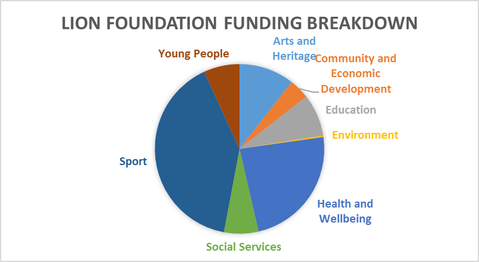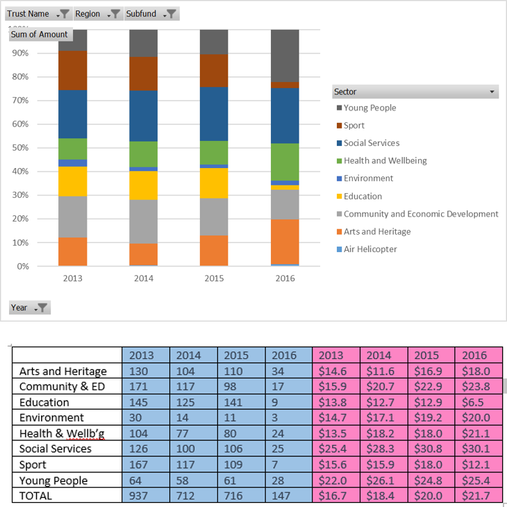
Air Rescue Community Services (ARCS) have over 400 machines in 30 venues throughout the South Island. They are a For Purpose Class Four gaming trust, meaning that, for 2015 calendar year, some 60% of their giving goes through to the associated charity, Canterbury West Coast Air Rescue trust (CWCART). The balance, goes largely to sport, with the remaining 7% through some select groups in various other sectors. So the data is quite interesting, but not particularly surprising.
However, what is interesting is a wee look at the financials of the organisations involved in the chain (30 June 2015).
Firstly, we have this gaming organisation, ARCS. It’s a fully owned subsidiary of CWCART, with two of the same directors. Last year they look to have given just under $4.3m from the gaming trust to CWCART – which is great, as that is what they were effectively established for.
CWCART’s additional funding state they received $748k from Westpac, $210k from NZ Coal and Carbon, $720k from direct mail, $273k from Westpac’s Awareness month, and “other donations” of $416k – raising a total of $6.9m.
CWCART itself seems to act as a simple pass through of funds to the service provider of the helicopters, a private business called Garden City Helicopters (GCH), which shares a shareholder with CWCART. The costs taken out of the Trust are largely administration costs at $922k, and included some $245k for wages of what seems to be the fundraising team (from a Stuff article), and an intriguing $222k for a fundraising review. You can check out their unaudited accounts on the Charities website.
The balance of the revenue – some $5.9m – seems to be distributed to GCH, who run the operation. They will be the ones who own the assets, who receive government funding for operations, employ the staff, and who manage operations. All very admirable. Unfortunately, we have no insights into how well that money is used: the website has no data on missions and minimal on cost structure.
I googled and found some interesting comparisons in terms of transparency. Otago’s charitable entity operating the helicopters there is Otago Rescue Helicopters Ltd, and Otago Rescue Helicopter Trust runs the fundraising side. A private business, Helicopters Otago, seems to own the helicopters, and I assume from the accounts that front line staff are employed by the Trust. They show some fabulous disclosure on their website: indeed I could see when they flew my mate Pete off Cardrona. Their annual report is a thing of beauty to a geek like me: we can use their numbers to benchmark. Otago’s accounts also have great notes about related party transactions – something also missing from CWCART’s accounts.
So if we look at Otago, we can see that in 2016 the taxpayer put $7,158 in per mission, which was topped up by donations of $1,698 per mission. Their costs / mission were $8931, which means they made a small loss in 2016. I do suspect that Otago’s flight times may be fairly high given the geography they cover: it looks like each mission takes around 1hour 40. So the costs per flying hour are around $5,113.
I had a look at other parts of the country to see what they do. They all seem to have different operating models. Now, the data is not always there to see what’s happening, but I have managed to pull something together. Canterbury? No data. We have no insights into how much you and me as taxpayers or givers, put in, as those funds go straight through to the privately owned business. So in terms of measuring how effective our tax, grant or sponsorship money is, then that takes some assumptions.
CWCART states on its own website that each mission costs $8625. Also on their website they state that they rescued over 800 people. Now, not every mission is about people, and over 800 is a bit vague, so let’s go with 900 missions. 900 * 8625 = $7.7m. They also state that 30% of costs are covered by the taxpayer – 900*8625*.3 = $2.3m. $7.7m less $2.3m means we can see a funding gap of $5.4m. However, the Trust actually distributed some $5.9m through to GHC. So why the excess $500,000 distributed to GHC?
The chart shows the workings: the operating costs look pretty similar. Total costs take operating costs and add on admin costs like fundraising. These costs of course are totally valid, as without spending the money, you can’t get the income. The variance in government dollars is puzzling: I put this down to different rates paid for different things – for example hospital transfers can be scheduled, but accidents of course require stand by.
Now, I love that this service is here. It’s most reassuring as I snow plough down Hutt that if I get wiped out by snowboarders I will be whisked to a hospital quickly. However, the lack of disclosure makes me uncomfortable, and I believe that donors – and tax payers – deserve a bit more around the efficiency of the organisation. All sorts of questions come to mind: is the operation subsidising other commercial elements? Why does the IP sit within a private business? Other structures have the human capital within the charity. How can we ensure the service provider is competitive in what should be an open tender process? I see GHC have had their contract reconfirmed by the CDHB (Star, October 20 2016). How could another provider actually have a crack at that contract? Legal billings for both ARCS and CWCART total $220k. Really? I have some mates who would like that client!
I also would hope that Westpac, who last year put $748k into CWCART, and CDHB, who together with other government agencies cover a stated 30% of the costs of this, are making their decisions on better information than what’s presented here. I also believe that, given they actually operate a gaming trust which, in 2015 took some $20m[i] out of the community, there is an obligation back to the community to show us that those funds are used in the most effective manner.
I could put in an OIA request and maybe get the information. But I shouldn’t have to, and really, as an organisation looking for support it’s actually incumbent on them to let us know they are doing. I would love to talk with you if you think this is vaguely interesting.
[i] Figure mentioned for maximum outrage. Almost half of this goes to the pubs themselves, the DIA for problem gambling services, and running of the machines themselves. It’s likely that the venue themselves would like machines regardless, so this dollar amount stays the same. The entity itself has costs of $2.5m which must be within the DIA guidelines. The balance went to the community.



 RSS Feed
RSS Feed